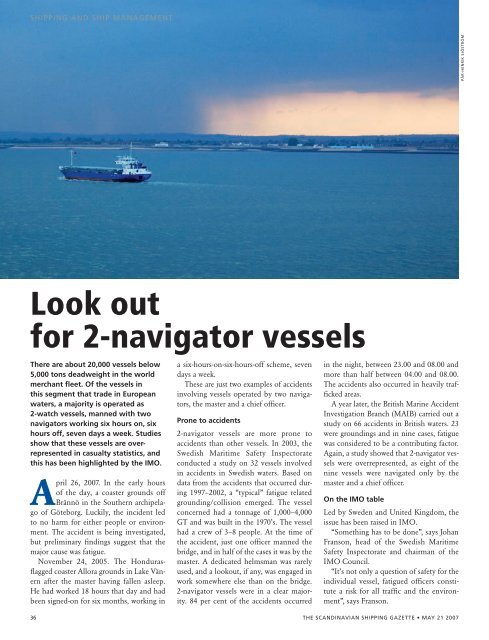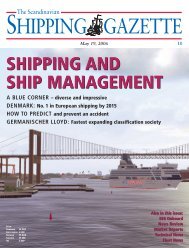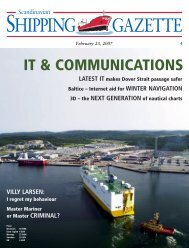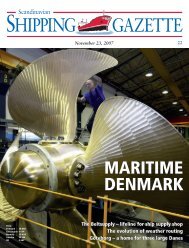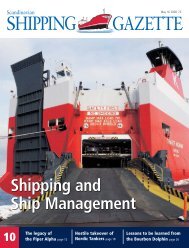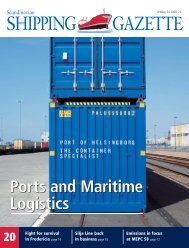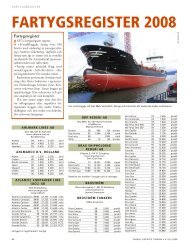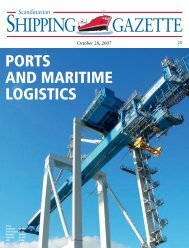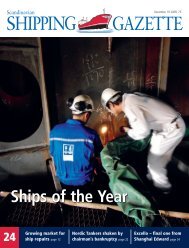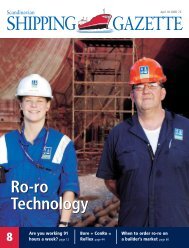SSG No 10 - Shipgaz
SSG No 10 - Shipgaz
SSG No 10 - Shipgaz
Create successful ePaper yourself
Turn your PDF publications into a flip-book with our unique Google optimized e-Paper software.
SHIPPING AND SHIP MANAGEMENT<br />
Look out<br />
for 2-navigator vessels<br />
There are about 20,000 vessels below<br />
5,000 tons deadweight in the world<br />
merchant fleet. Of the vessels in<br />
this segment that trade in European<br />
waters, a majority is operated as<br />
2-watch vessels, manned with two<br />
navigators working six hours on, six<br />
hours off, seven days a week. Studies<br />
show that these vessels are overrepresented<br />
in casualty statistics, and<br />
this has been highlighted by the IMO.<br />
April 26, 2007. In the early hours<br />
of the day, a coaster grounds off<br />
Brännö in the Southern archipelago<br />
of Göteborg. Luckily, the incident led<br />
to no harm for either people or environment.<br />
The accident is being investigated,<br />
but preliminary findings suggest that the<br />
major cause was fatigue.<br />
<strong>No</strong>vember 24, 2005. The Hondurasflagged<br />
coaster Allora grounds in Lake Vänern<br />
after the master having fallen asleep.<br />
He had worked 18 hours that day and had<br />
been signed-on for six months, working in<br />
a six-hours-on-six-hours-off scheme, seven<br />
days a week.<br />
These are just two examples of accidents<br />
involving vessels operated by two navigators,<br />
the master and a chief officer.<br />
Prone to accidents<br />
2-navigator vessels are more prone to<br />
accidents than other vessels. In 2003, the<br />
Swedish Maritime Safety Inspectorate<br />
conducted a study on 32 vessels involved<br />
in accidents in Swedish waters. Based on<br />
data from the accidents that occurred during<br />
1997–2002, a “typical” fatigue related<br />
grounding/collision emerged. The vessel<br />
concerned had a tonnage of 1,000–4,000<br />
GT and was built in the 1970’s. The vessel<br />
had a crew of 3–8 people. At the time of<br />
the accident, just one officer manned the<br />
bridge, and in half of the cases it was by the<br />
master. A dedicated helmsman was rarely<br />
used, and a lookout, if any, was engaged in<br />
work somewhere else than on the bridge.<br />
2-navigator vessels were in a clear majority.<br />
84 per cent of the accidents occurred<br />
in the night, between 23.00 and 08.00 and<br />
more than half between 04.00 and 08.00.<br />
The accidents also occurred in heavily trafficked<br />
areas.<br />
A year later, the British Marine Accident<br />
Investigation Branch (MAIB) carried out a<br />
study on 66 accidents in British waters. 23<br />
were groundings and in nine cases, fatigue<br />
was considered to be a contributing factor.<br />
Again, a study showed that 2-navigator vessels<br />
were overrepresented, as eight of the<br />
nine vessels were navigated only by the<br />
master and a chief officer.<br />
On the IMO table<br />
Led by Sweden and United Kingdom, the<br />
issue has been raised in IMO.<br />
“Something has to be done”, says Johan<br />
Franson, head of the Swedish Maritime<br />
Safety Inspectorate and chairman of the<br />
IMO Council.<br />
“It’s not only a question of safety for the<br />
individual vessel, fatigued officers constitute<br />
a risk for all traffic and the environment”,<br />
says Franson.<br />
36 THE SCANDINAVIAN SHIPPING GAZETTE • MAY 21 2007<br />
Pär-HENrIk SjöSTröM


